20. SPOTSYLVANIA COURT HOUSE – SPOTSYLVANIA, VIRGINIA
Spirits roam one of America’s bloodiest battlegrounds.
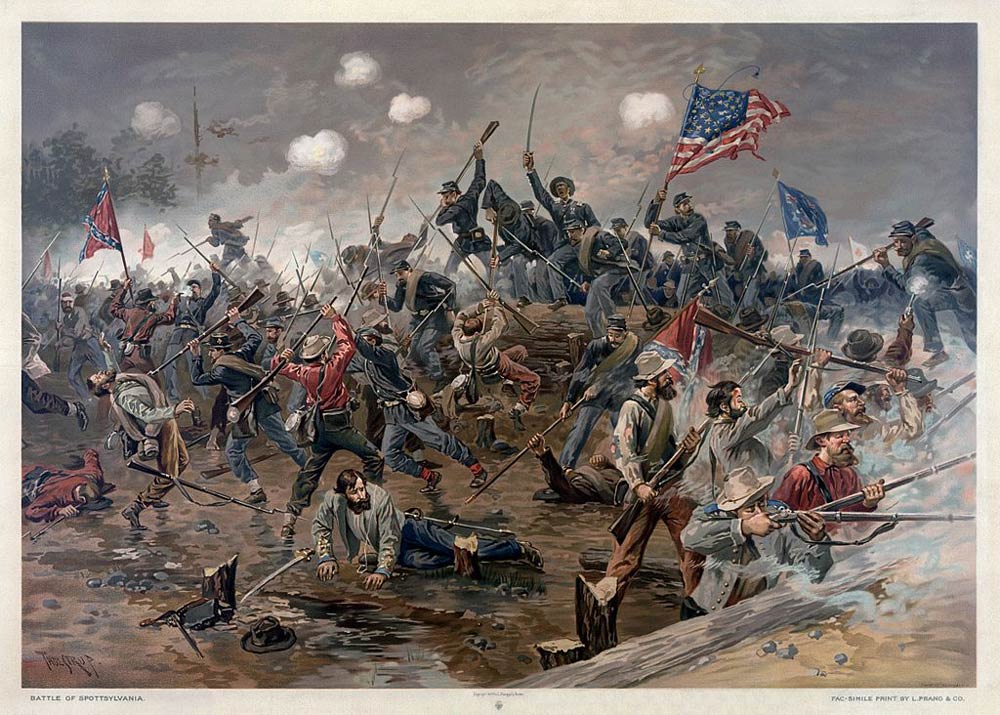
Image Source: Totally History
There’s a lot to do and see at Fredericksburg and Spotsylvania National Military Park. The park was established in 1927 and was listed on the National Register of Historic Places in 1966. Today, visitors have over 8,374 acres to explore. But what the park is most famous for is being “the bloodiest ground in North America.”1 Each of its historic must-sees thus offers an important and violent piece of Civil War history.
Field Hospitals
Firstly, the park has four well-preserved historic structures: Chatham Manor, Ellwood Manor, Salem Church, and the “Stonewall” Jackson Shrine. All of them were transformed into field hospitals during the war. They became where soldiers sought treatment for their wounds, or died because of them. When the famous Walt Whitman visited Chatham Manor, for example, he was stunned to see “a heap of amputated feet, legs, arms, hands, etc.”2 lying right outside the house.
And since it wasn’t unusual for bloody conflict to erupt near estates, both the Chatham and Ellwood mansions were also used as Union headquarters for awhile. What their owners witnessed and experienced when their homes were taken over prove that even civilians had to deal with first hand carnage.
Salem Church would also be victimized by the war. In 1862, the citizens of Fredericksburg were forced to evacuate their town. The homes they left behind were quickly pillaged and destroyed by Federal invaders. Confederate forces would take a stand against them at Salem Church in 1863. Like the two manors, the small, brick house of worship became a scene of gore and chaos. The report from one eyewitness is disturbingly similar to Whitman’s:
Limbs
“The amputated limbs were piled up in every corner almost as high as a man could reach; blood flowed in streams along the aisles and the open doors.”3
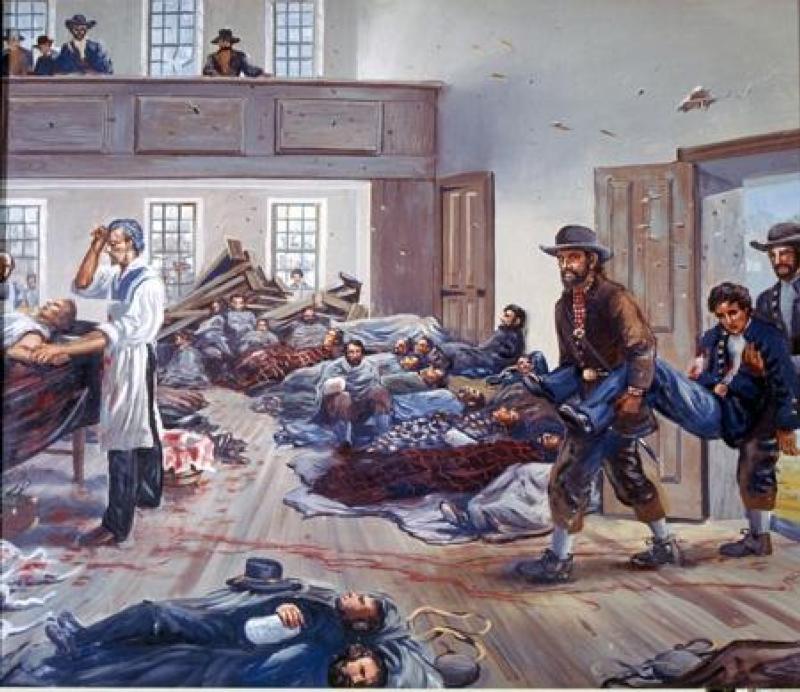
Image Source: Nps.gov
Ellwood Manor also has its own limb story. It is where Thomas Jonathan “Stonewall” Jackson’s amputated left arm is interred. Jackson was a famous Confederate general known for leading his troops to victory despite facing terrible odds. Unfortunately, he was accidentally shot by his own men on May 2, 1863. The bullet ripped through his left shoulder, so surgeons had to remove the injured limb. Jackson was then transferred to one of Chandler plantation’s outbuildings, where he died from pneumonia. Today, the“Stonewall” Jackson Shrine commemorates his name.
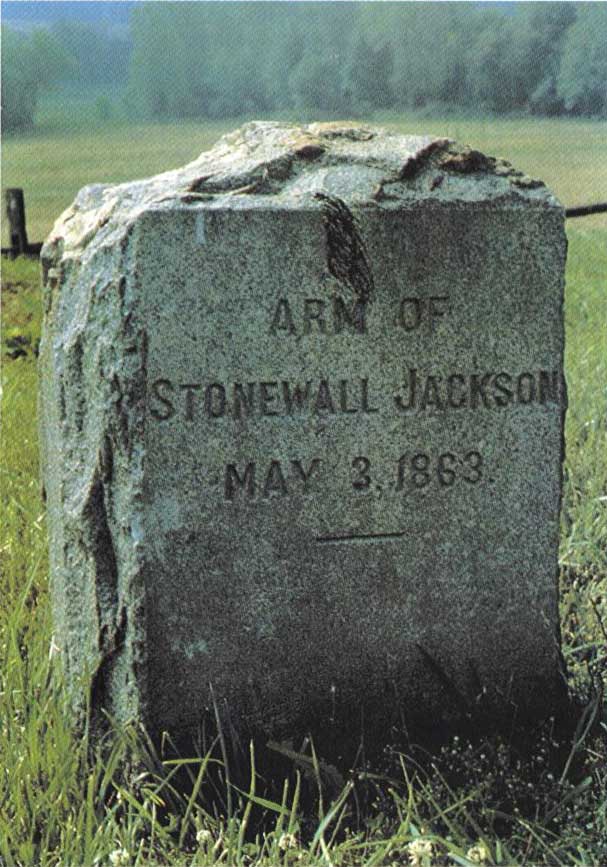
Image Source: Eg.bucknell.edu
Spotsylvania Cemeteries
Fredericksburg and Spotsylvania National Military Park also has three cemeteries. In theFredericksburg National Cemetery, over 15,000 Union soldiers lie buried, as well as several slaves. Its two other cemeteries are dedicated to fallen Confederates. Unfortunately, most of the soldiers interred in these graveyards lie buried in mass graves because they have never been properly identified. It is sad that they must spend eternity in unmarked resting places, despite giving their lives in defense of their nation.
The stories behind these four structures and three cemeteries offer just a snapshot of the park’s bloody past. To get the full picture, one must see its battlefields. Four major Civil War battles occurred at the park: the Battle of Fredericksburg, the Battle of Chancellorsville, the Battle of the Wilderness, and the Battle of Spotsylvania Court House. In total, there were over “85,000 men wounded; 15,000 killed”4 across all four engagements.
The Battle of Spotsylvania Court House was the longest and bloodiest of these battles. From May 8 to May 21, 1864, the troops of Union General Ulysses S. Grant and Confederate General Robert E. Lee clashed at the pivotal crossroads of Spotsylvania Court House. Though it lasted two weeks, the battle ended inconclusively and was the most costly fight during the Overland Campaign. About 32,000 men were killed, wounded, or could not be found. It thus “is one of the top five bloodiest battles that occurred during the American Civil War.”5

Image Source: Wikipedia
Spotsylvania Court House : Witness To Gore
After a devastating defeat from the Battle of the Wilderness, General Grant withdrew from Richmond and led his forces south towards Spotsylvania. But when they arrived at the town’s court house, Confederate soldiers were already there. General Lee had anticipated General Grant’s maneuver, so had sent already sent a team of men to entrench the area.
During the battle, many other buildings within the district fell in the path of conflict, including a tavern, two churches, and a farmhouse. But the court house, as the town’s focal point, witnessed the most gore.

Image Source: Wikipedia
Spotsylvania Court House was built in 1840 and is an example of Roman Revival architecture. During the war, it was so devastated by artillery fire that the Clerk of the Court had to request the governor to have it repaired in 1900. Since then, the court house has been well preserved.
Combat
The first few days of battle were spent fortifying the area and keeping a watchful eye on the enemy. On May 11, a torrential rainstorm hit Spotsylvania, spoiling much of the Confederate’s gunpowder. Thus, General Grant decided it was the opportune moment to plan a grand assault. He gave notice to Major General Winfield S. Hancock to begin assembling his men in preparation for an early morning attack the next day.
Combat on May 12 was especially chaotic. 9,000 Union and 5,000 Confederate Soldiers were killed during this day-long skirmish. Through a thick mist at 4:35 AM, the Union Army attacked the enemy. They focused their assault on “the only weakness”6 in the Confederate’s defense line, Mule Shoe. The heaviest fighting happened along Mule Shoe’s western edge. This area, now known as the “Bloody Angle,” witnessed some twenty hours of gruesome conflict.

Image Source: Npsfrsp.wordpress.com
Landscape Destroyed In Battle
By 8 AM, most of the Union and Confederate armies had reached the Bloody Angle. Rain continued to pour heavily down, making the ground muddy and very slippery. Fighting was difficult and had to be done hand-to-hand because of the downpour. Despite the weather and wet terrain, Union soldiers managed to break through the Confederate’s defenses. General Lee was forced to withdraw his troops in order to focus on constructing new entrenchments. By the time they left, the landscape was completely leveled, and all foliage was destroyed. The next day, Union soldiers reviewed the gory remnants of their enemies:
“They were lying literally in heaps, hideous to look at. The writhing of the wounded and dying who lay beneath the dead bodies moved the whole mass…”7
Final Union attacks began on May 17, and the Battle of Spotsylvania Court House would end at Harris Farm two days later.
Presence Felt To This Day
The present appearance of the Spotsylvania Court House belies its bloody past. But there are still pieces of its violent history that remain well intact. The Smithsonian Museum of American History has preserved a 22-inch tree stump from the Bloody Angle that was severed by rifle fire, for example. And much of the battlefield’s extensive earthworks look as they did when the Confederates first constructed them. But what also has been sustained is pain and misery.
The torment of the countless soldiers who lost their lives at Spotsylvania Court House is felt to this very day. Many who visit the park say that they immediately feel cold and depressed. Perhaps what they are sensing is the suffering of a wounded soldier, or the anguish of a Civil War volunteer.
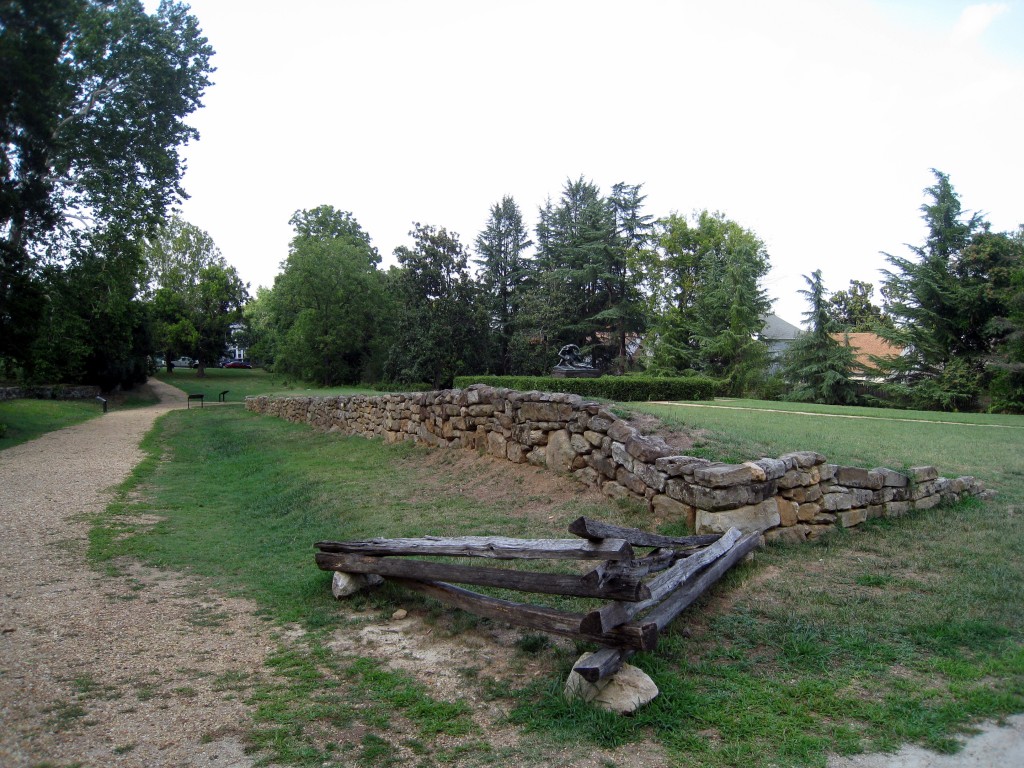
Image Source: Wikipedia
The park has thus been attracting ghost hunters for years. Evidence has been documented at multiple locations. Electromagnetic field readings, for instance, have been gathered at the “Stonewall” Jackson Shrine. A young female ghost has been seen wandering the grounds of Chatham Manor. But the park’s most active area has to be the Bloody Angle. So supernaturally hot is the Bloody Angle that researchers are known “to drop bits of beef jerky and chewing tobacco on the ground to try to lure the spirits of dead soldiers from hiding.”8
Historian Mark Nesbitt has investigated the site several times. During one of these visits, he captured two impressive EVPs:
“In the first, I address the men of the 15th New Jersey who fought at the angle. There is a gruff answer for the first question and no answer for the second. During the second EVP, I addressed the men from Ohio who fought there as ‘Buckeyes.’ After the first question, ‘You fought here didn’t you?’ at 5 seconds, I hear an affirmative answer.”
Psychic Investigations
Nesbitt has also led psychic investigations at the Bloody Angle as well. When medium Patty Wilson joined him at the battlefield in September 2007, she got several readings. Apparently, many spirits wanted to share their stories with her, including a young Confederate who died under a tree and a Union soldier with a missing cheekbone. The descriptions of fighters – stumbling over corpses, fighting with clubbed muskets, collapsing from dehydration, etc. – from her visions were vividly real.
Thick, spectral fogs frequently appear around the battlefield, adding to its spookiness. Through these ominous mists, people have seen the apparitions of soldiers emerge. Many have even snapped photographs of ghostly orbs and other anomalies.
Civil War reenactments are frequently staged at the park. But many have seen soldiers wandering around, even when none are being performed. And it’s not uncommon to hear the sounds of disembodied cries, screams, and gun fire around abandoned trenches. People have also gotten the disquieting sense of being watched as they tour the park’s grounds. Is it the ghost of an abused slave who is gazing at them? Or the spirit of a soldier, envious of their four limbs?

Image Source: Wikipedia
Book a Williamsburg Tour and see for yourself
Our tour will take you on a leisurely stroll along the tree-lined cobbled streets of this beautiful and historic city. In around three-quarters of a mile on our standard tour, our entertaining and knowledgeable guide will regale you with stories of characterful spots in the Historic District of Williamsburg.
For those with an appetite for the terrifying, our extended tour will take in an additional haunted locations.
Get more information and reserve a tour today!
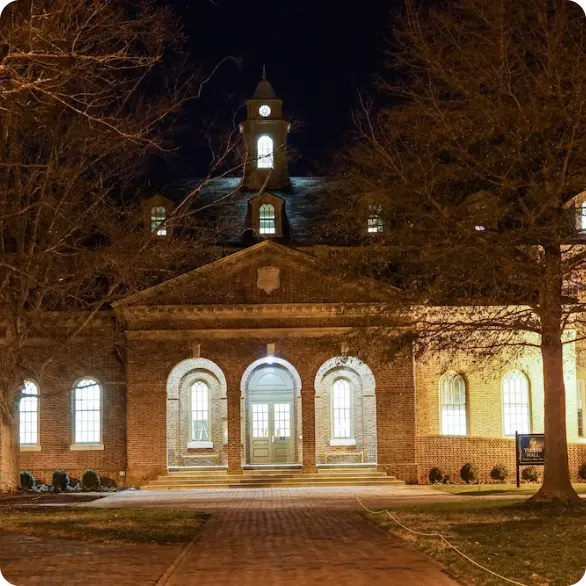
Works Cited
- “Fredericksburg and Spotsylvania National Military Park.” Civil War Discovery Trail – Battlefields. Civil War Trust, 2014. Web. 23 September 2015.
- “Chatham Manor.” Places – Chatham Manor. History & Culture – Fredericksburg & Spotsylvania National Military Park. National Park Service, 2015. Web. 24 September 2015. Para. 12.
- “Salem Church.” Places – Salem Church. History & Culture – Fredericksburg & Spotsylvania National Military Park. National Park Service, 2015. Web. 24 September 2015. Para. 16.
- “America’s Battleground.” Fredericksburg & Spotsylvania National Military Park. National Park Service, 2015. Web. 24 September 2015.
- “Battle of Spotsylvania Court House.” Totally History, 2012. Web. 23 September 2015. Para. 18.
- “Battle of Spotsylvania Court House.” Totally History, 2012. Web. 23 September 2015. Para. 12.
- “History of Wilderness and Spotsylvania.” Stories – The Fields of Battle. History & Culture – Fredericksburg & Spotsylvania National Military Park. National Park Service, 2015. Web. 24 September 2015. Para. 39.
- “Halloween Haunts and Ghost Stories in the Fredericksburg Region.” Greater Fredericksburg Tourism Partnership, 2015. 16 October 2014. Web. 23 September 2015. Para. 7.
- Nesbitt, Mark. Civil War Ghost Trails: Stories from America’s Most Haunted Battlefields.Mechanicsburg: Stackpole Books, 2012. Page 160.
